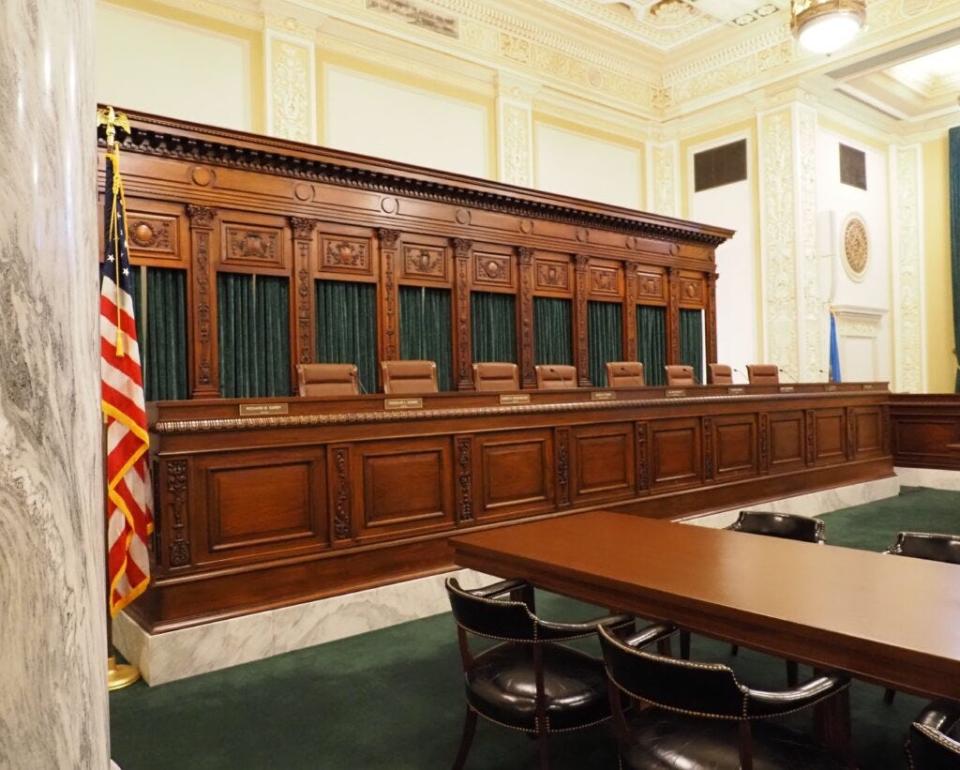Christmas Eve morning in 2022, Stacy Staggs felt an unexpected chill. When she got out of bed to investigate, she realized the power was out and so was the heat.
Immediately, she went to check on her daughter. She relies on life-saving medical equipment that runs on electricity. Her battery backup went into effect at some point during the night, but Staggs knew it would only last so long. She needed to know would the power come back soon, or should she find a hotel room or a friend to get the equipment back on track.
It wasn’t until hours later she found out her outage was no accident.
Like 500,000 other Duke Energy customers across the Carolinas, the utility intentionally shut off her power as a part of an emergency load-shedding procedure to prevent total grid failure. On the coldest morning of the year, as energy use peaked, and power plants began to fail, Duke Energy found there simply wasn’t enough power to go around.
“Someone along the line, in the wee hours of the morning, somebody pushed a button, and they did not know how many people they were putting in mortal danger,” Staggs said.

What happened?
In hindsight, the fate of the power grid was sealed by Dec. 21. A massive winter storm formed over the northern plains and moved east over the next few days, bringing blizzard conditions, strong winds and brutal cold to the eastern two-thirds of the continental United States.
It hit the Carolinas on the evening of Dec. 23 and while neither state saw much snow, high winds and polar air meant temperatures dropped rapidly overnight. By Christmas Eve morning, the Charlotte area saw temperatures in the single digits and wind chills below zero.
This system triggered several compounding effects:
1. Energy use was far higher than Duke Energy expected it needed to provide.
2. Power plants began to suffer weather-related failures.
3. Neighboring utilities that would normally sell Duke excess energy faced the same power squeeze, so they held onto their electricity.
Just after 6 a.m. on the morning of the 24th, both Duke Energy Carolinas and Duke Energy Progress entered energy emergency alert level three and began load shedding, shutting off power to customers in increasing amounts until about 8 a.m.
The directive ended around 10 a.m.
Could this have been prevented?
The storm system was the trigger for the grid failure, but the load shed was not inevitable. Duke Energy and other utilities on the eastern power grid could have taken steps in advance to avoid or reduce the impact of the load shed events.
According to a report to South Carolina regulators, Duke’s model for the winter storm event dramatically underestimated how much power customers would demand, which guided the utility’s decisions leading up to the event.
Duke typically schedules power plant maintenance over the fall and spring, as these seasons tend to coincide with lower energy usage. In 2022, most of the maintenance was expected to be complete by Dec. 19, but an issue discovered during inspection meant the Robinson Nuclear Plant could not come online until Dec. 30.
SEE MORE: Duke Energy could reimburse customers for losses related to recent rolling blackouts
Additionally, Duke took several other generators offline earlier in the fall due to emergent issues requiring immediate maintenance. Supply chain disruptions meant many of those repairs were delayed until after the storm.
The utility does have power plants that function in a reserve capacity, like the Allen Steam Plant in Gaston County, but given the plant had not run for all of 2022, it would have taken five days for Duke Energy to get the plant up and running. Based on its forecast going into the winter storm, Duke management did not believe it would be necessary to bring the Allen plant online. By the time the utility was able to adjust its forecast, it was too late.
In total, before the storm began, Duke was already operating with 3,895 MW worth of its power generation was unavailable. Once the system rolled through, freezing and other equipment failures meant another 2,260 MW of power was unavailable.
VIDEO BELOW: 9 Investigates Part 2: Will the lights stay on?
How did power return?
Duke Energy’s power generation began to stabilize as the sun came up, solar power generation entered the grid and temperatures increased. By about 10 a.m. Duke ended its load shed order and was supposed to resume its power distribution. Instead, the software designed to restore power wasn’t working and hadn’t been for most of the load shed event.
The software was supposed to automatically rotate the outages during the load shed event so customers only lost power for roughly 15-30 minutes. The software failed meaning Duke had to manually turn power back on to customers once the load shed event was over. Nearly all customers had their power back by 4 p.m. but some were in the dark for 10 hours.
What has Duke done since?
Duke Energy committed to 101 corrective actions starting with fixing and testing that outage software.
“We hope to never have to use that technology again but if we do, but if the situation arises that we do, we want to give our customers a better experience, one they can manage through a little easier,” Duke Energy spokesman Jeff Brooks said.
According to Brooks, Duke has also adjusted its planned outage schedules so facilities must be back online by Dec. 1. This year, all plants were able to comply by that timeframe.
SEE WHY: New rules for Duke Energy customers means less savings for going solar
The company has also worked to adjust its forecasting models, using the lessons learned from the winter storm. While the Carolinas have faced temperatures lower than they did on Dec. 24, 2022, they typically come in January or February, so the models have been adjusted to reflect the potential for higher power demand earlier in the winter.
Duke is also adjusting its winterization strategies and infrastructure, as well as its communications technology to improve its messaging to customers. On Dec. 24, customers did not get any notice about the potential for blackouts or the need to conserve energy. Brooks said Duke will take that into account for future planning. He said Duke sent out messaging on Dec. 25 asking customers to conserve energy to protect the grid and it helped the utility decrease demand and keep power flowing.
Can it happen again?
While some of the issues Duke faced were unique to the utility, utility companies across the eastern energy grid faced similar winterization and modeling issues.
The joint report on the 2022 winter storm from the Federal Energy Regulatory Commission and the North American Electric Reliability Corporation revealed six different utility operators, Tennessee Valley Authority, Louisville Gas and Electric, Santee Cooper, Dominion Energy South Carolina, Duke Energy Progress and Duke Energy Carolinas, had to resort to load shedding to keep the energy grid from failing.
The report recommends better national standards for winterizing the power grid and our fuel distribution infrastructure. The U.S. Department of Energy is also offering more than $7 billion in grants to help improve, decarbonize and expand the country’s energy grid. North Carolina received $18.5 million in the first round of funding.
What makes a resilient power grid?
As associate director of UNC Charlotte’s Energy Production and Infrastructure Center, Dr. Robert Cox has been researching what it takes to produce and distribute critical power services reliably for years.
With the massive population growth, demand from new manufacturing facilities, and the electrification of heat and cars, Cox said energy demand in the Carolinas is rapidly rising, especially during the winter.
“Our winter peak is as large as our summer peak and that’s going to continue to grow,” he said. “The problem that we really have is there’s not really a good resource to deal with the winter peaking of the grid.”
Currently, the Energy Information Administration describes North Carolina’s energy portfolio as a mix between natural gas (39%), nuclear (34%), coal (12%) and renewables (13%) but Duke Energy plans to phase out all its coal production by 2036 to meet the state’s net-zero carbon emissions deadline of 2050.
Coal plant failures during the 2022 winter storm proved the fuel isn’t a perfect supplier of winter energy, but so far, Cox said its replacements haven’t been either. According to FERC, 47 percent of energy generation failures during the 2022 storm were at natural gas plants.
“Nuclear, coal, and natural gas are the most reliable right now,” Cox said. “But there are still some challenges with winterization of those assets.”
Meanwhile coal and natural gas are responsible for most the energy sector’s carbon emissions.
Can we produce enough power while reducing carbon emissions?
That’s the million-dollar question.
ALSO READ: NC sheriff says Duke Energy is slowing investigation into power grid attacks
Renewable energy generation has come a long way in the past few decades, and now solar production has a massive footprint on the state, but Cox said there’s still one thing fossil fuels can do that most renewables can’t. That’s running on demand.
“We need what’s called dispatchable generation,” he said. “We’re going to need to find the technologies that allow us to be able to dispatch that allow us to be able to call upon, whatever resource we need whenever we need it.”
Solar and wind are intermittent technologies, which means they provide power when the sun is shining, and the wind is blowing and stop when those resources aren’t available. Battery storage technology and places like the Bad Creek pumped storage facility, can help make that energy available during those off periods but Cox said batteries aren’t nearly as powerful as they need to be yet, and pumped storage takes years to build.
“In the utility world they’re used to resources that last many decades, and batteries just can’t do that right now,” he said.
Cox said he’s optimistic future technology like hydrogen plants and small modular nuclear reactors could become those zero-emitting, dispatchable energy resources. As of right now, the two most reliable carbon-free technologies are nuclear and offshore wind.
“That’s going to be the most reliable during that winter time period,” he said.
Unfortunately, those options are also the most expensive to build, and projects take years to get off the ground. Duke Energy has both in its long-term carbon plan, but neither is expected to get connected to the grid until the mid-2030s.
Is there hope?
Cox is optimistic. He believes the next decade will include several breakthroughs in renewable and zero-emitting technologies, but a smart grid design can significantly reduce carbon emissions using our current intermittent renewable technologies if it takes into account which technology will be available when.
Hydro can work to supply power when solar cannot and offshore turbines will bring more reliable and consistent wind power.
WHAT HAPPENED: Officials hear from customers after Duke Energy requests rate hike
Reducing demand on the grid can also go a long way. Things like home solar systems and batteries can help reduce personal dependence on the energy grid, leaving more generation at the utility level to go around. A more solar-reliant grid might also benefit from a shift in energy-use habits, running appliances or charging your vehicle in the middle of the day when energy is more abundant means that power can go farther.
Cox argues it will take a change in policy, resource management, and a large buildup of infrastructure to get there, but the biggest barrier is finding that final piece of the puzzle, a dispatchable, zero-emitting energy generator.
“We can get most of the way to net-zero carbon,” he said. “It’s going to be that last little bit that’s going to be challenging.”
(WATCH: Homeowners say Duke Energy left mess after trimming trees near power lines)
Signup bonus from





